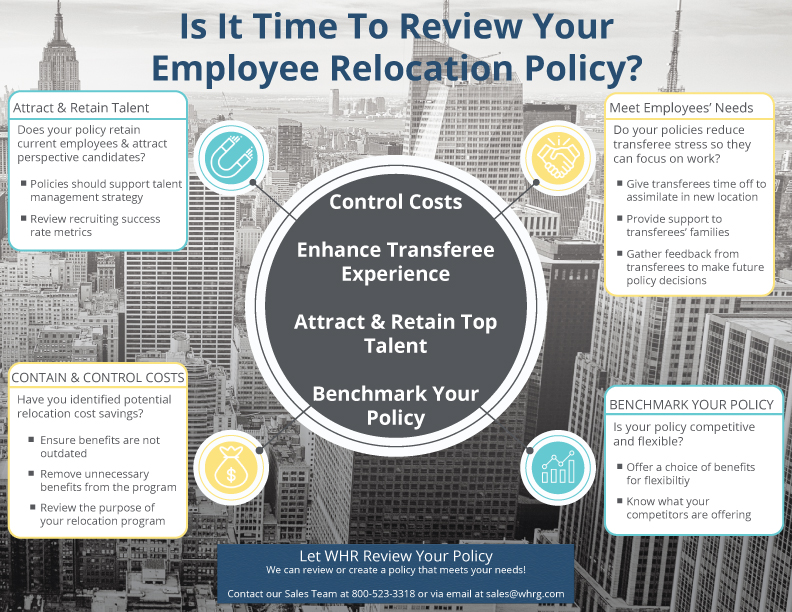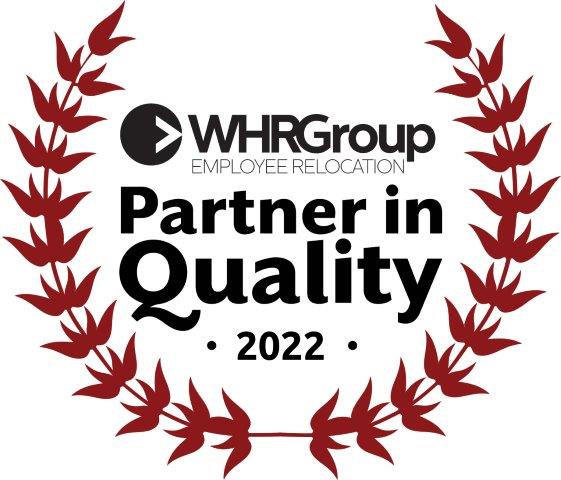Why should you bother reviewing your relocation policy?

Even though many companies now allow all-remote or hybrid work, they are still relocating employees to fill needed roles and help attract/retain top talent. To be successful, your organization needs a well-prepared and comprehensive relocation policy in place to help in the following areas:
- Control business costs
- Ensure you’re meeting employee needs
- Attract and retain top talent
- Benchmark your policy against the competition
As a Relocation Management Company (RMC), WHR Group, Inc. (WHR) conducts policy reviews. The following examples demonstrate just how important it is to review your relocation policy regularly. If you don’t already have a policy, you’ll want to create one. Here’s why it’s all so important:
A. Control Business Costs. Are You Paying for Unnecessary Benefits?
Make sure you’re allocating the right amount of dollars to both transferees and organizational needs. It’s also important you’re not paying for unneeded or outdated benefits.
Example #1
A company was giving each transferee a standard $5K-$10K relocation lump sum to assist with any extra expenses. They were also giving executives a lump sum equal to 6 weeks’ salary on top of the $5K-$10K lump sum. Since some executives had large salaries, this allowance sometimes equated to $50K per executive! After review, we recommended the company cut back on that practice for executives. The company saved hundreds of thousands of dollars.
Example #2
A client was paying a cost-of-living differential if the employee was relocating to a higher-cost area. They were paying this out for 3-4 years, plus they were also providing a big lump sum benefit. We recommended a minimum 5% cost of living threshold so that they were not paying transferees moving to only slightly higher cost of living areas. The client saved millions.
Example #3
Another client was giving out non-promotional bonuses to current employees willing to relocate for a lateral role. These bonuses equated to 5% of the employees’ salaries. Since this practice is not common, we recommended they eliminate this from their relocation policy. This saved them significant costs without lowering the value of their program.
Example #4
One of our clients was paying a loan origination fee. Some lenders don’t even charge this fee but if they know the client will pay, they will still charge the fee anyway. Once we alerted the client, they stopped paying the fee unless necessary.
B. Meet Your Employees’ Needs
Is your relocation policy meeting your employees’ needs? The right policy helps to reduce transferee stress so that employees can focus on working in their new location. Giving employees time off to assimilate in their new location, providing support to transferees’ families and gathering post-relocation feedback to make future policy decisions will all help to address your transferees’ needs.
Example #1
One of our clients was offering a lump sum benefit for all international relocations. By gathering post-relocation survey feedback, we found out transferees were trying to coordinate their international household goods (HHG) shipments and were not spending the full lump sum in the hopes of keeping some of the money. Survey feedback also showed that giving employees that level of choice was adding more stress on them, and it was making the relocation process take longer. Transferees were trying to do it all on their own, plus pinch pennies.
The client considered all key benefits and determined the lump sum was not working. They shifted from a lump sum to a core flex benefit. This meant the client would cover HHG shipments, destination service providers and temporary housing, but they still gave transferees a lump sum amount to be used at the employees’ discretion. Not only did this help reduce transferee stress but it also helped control business costs.
Example #2
One client was not offering destination services to spouses/partners and families of intra-European moves. They assumed that if a transferee/family was relocating from Romania to the UK, for example, destination services were not needed. Through post-relocation survey feedback, it was determined that spouses/partners needed career assistance, language training and help with school searches for their children. The employee had office workers to help them assimilate in the new locations, but the transferees’ partners were struggling with the new language, and even struggling to find necessities like grocery stores. Recognizing the needs of the entire family unit, and not just the transferee is crucial to ensuring a successful move and assimilation.
C. Attract & Retain Talent by Benchmarking Your Policy Against the Competition
Hopefully, your relocation policy is already part of your total rewards and talent management strategy. The right policy will help your company retain current employees and attract top prospective candidates. A weak relocation policy could have a negative impact on your recruiting and retention success rate.
By benchmarking your policy against other companies, you will stay competitive in the war for talent. Make sure your policy provides a choice of offerings since relocation policies are wrapped into job offers. If you don’t benchmark against your competitors, you won’t know if your offerings are good or not. Are they subpar to what everyone else is offering? If you are hiring high-level executives, for example, and the talent is very specific and not easy to come by, you’ll want to make sure you’re competitive with salary, benefits and your relocation policy.
At the same time, benchmarking will ensure you’re not giving away too much when none of your competitors are doing that. Benchmarking your policy against others shows you are in line with the industry. It’s also important to look at your industry and other industries you compete with for talent.
Example #1
Imagine losing a potential candidate because your relocation policy is missing benefits your competitors are including. For example, if your candidate is an executive expecting a full house buyout, but your policy only includes an HHG move and lump sum payout, then you must go back and forth negotiating with your superiors and the candidate. This can waste a lot of time. In the interim, the candidate might receive a better job offer, including more relocation benefits. A relocation policy can be a factor for candidates deciding whether to take one job over another. If you’ve benchmarked your policy against your competition, you’ll already know what their policies include.
Example #2
A client was getting feedback from its talent acquisition team that it was difficult filling certain positions. After reviewing their policy and benchmarking it against their competitors, we discovered that their competition was offering far richer relocation benefits. As a result, the company decided to expand its range of jobs eligible for full relocation benefits.
How often should you review your policy?
WHR recommends you review your employee relocation policy annually, or every couple of years at the very longest. It does not have to be a huge overhaul, but it’s a chance for you to pause and look at employee feedback, plus confirm any changes in your company culture, driving principles, core values, talent strategy, the industry and your competition. This is a time for you to make sure your policy is aligned with all those pieces and your key stakeholders (talent acquisition teams, recruiting teams and HR business partners).
WHR is available to review and/or write your relocation policy (domestic and/or international).





